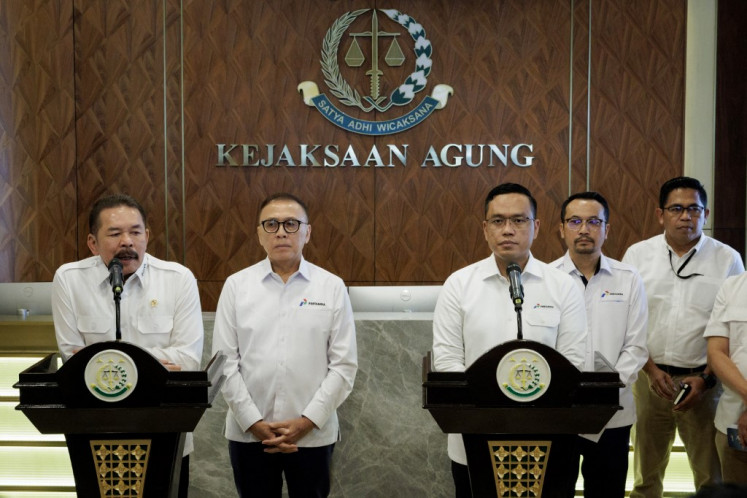Popular Reads
Top Results
Can't find what you're looking for?
View all search resultsPopular Reads
Top Results
Can't find what you're looking for?
View all search resultsInfrastructure lacking for drivers of electric vehicles
Online-based ojek (motorcycle taxi) driver Adi Suhadi skillfully zigzags his motorcycle between cars that are stuck in traffic on the way to Tanah Abang Station in Central Jakarta, where his passenger is waiting for him
Change text size
Gift Premium Articles
to Anyone

O
nline-based ojek (motorcycle taxi) driver Adi Suhadi skillfully zigzags his motorcycle between cars that are stuck in traffic on the way to Tanah Abang Station in Central Jakarta, where his passenger is waiting for him.
At first glance, Adi’s motorcycle looks just like any other on the road. However, when his motorbike starts to move, passengers easily notice that it is different.
“They often ask me why the ride feels a lot smoother than the usual motorcycles,” he told The Jakarta Post on Monday. “That’s when I tell them that mine is electric-powered, not fuel-powered.”
Although he has been working as an ojek driver since 2015, Adi only changed his bike to an electricity-powered one in July after participating in an electric motorcycle test ride organized by his employer. Since then, he has been hooked on the convenience, efficiency and environment-friendly aspects of the bike.
The 54-year-old said he only needed to plug the battery into any power socket overnight every day to fully charge it. A single battery charge takes him as far as 60 kilometers with a top speed of 60 km per hour.
“Charging the battery certainly hiked my house’s electricity bill, but I can still afford it because I don’t have additional expenses on regular maintenance like fuel-powered motorcycles,” he explained.
Unfortunately, not many Jakartans are interested in switching to electric vehicles.
Sutjipto Atmodjo, marketing director for Viar Motor Indonesia, which produces the Viar Q1 electric scooter that has been in mass production and sold in Indonesia since October 2017, said that his company had only sold 1,000 to 2,000 electric motorcycles nationwide, with the majority of them purchased in Greater Jakarta.
Meanwhile, Muhammad Al Abdullah, the CEO of the Garansindo Group, a vehicle distributor that imports the Zero electric motorcycle from the United States, said that the sales of electric motorcycles was insignificant as it only targets a niche market.
Meanwhile a local venture, PT Gesits Technologies Indo (GTI) in West Java, is beginning the mass production of locally built electric scooters, one of which was recently test-driven by President Joko “Jokowi” Widodo, that will enter the market this December.
However, the lack of infrastructure plays a part in causing the public to opt for gasoline-powered motorcycles, which have about the same price tag, rather than electric ones.
Although state-owned electricity firm PLN had provided more than 1,000 charging stations throughout Greater Jakarta that can be found with a search on Google Maps, Sutjipto said those charging stations are often located in unguarded areas, rather than in public spaces that have security officers and CCTV cameras like shopping centers or office buildings.
“Customers will definitely question the security of their vehicles when they charge them because they need to leave them for hours,” he said.
PLN electric vehicle team leader Doddy B. Pangaribuan said that the charging stations were initially intended to provide electricity to street vendors.
However, since electric vehicles, particularly electric-powered motorcycle, started to gain popularity in the city, PLN also promoted the stations to motorists to charge their bikes.
“The stations work like at-home pre-paid electricity meters,” he said. “Customers only need to buy credits to charge their bikes.”
While electric-motorcycle owners in Jakarta might only have to face unguarded charging stations, electric car owners must face a more challenging problem: the lack of any car-charging stations.
Even though auto producers, like Toyota and BMW, have started to bring their electric cars to the country, people have yet to shift to those eco-friendly vehicles because of their high prices and the lack of charging
stations.
The lack of stations, Doddy said, is caused by the cars’ different charging methods and their bigger power consumption, which has led PLN to only provide three car charging stations in the city, located in Gambir in Central Jakarta, Duren Tiga in South Jakarta and in the Taman Mini Indonesia Indah (TMII) complex in East Jakarta.
Those stations, he said, are currently only serving as trials, given that electric cars are still uncommon in the city because of their high prices.









